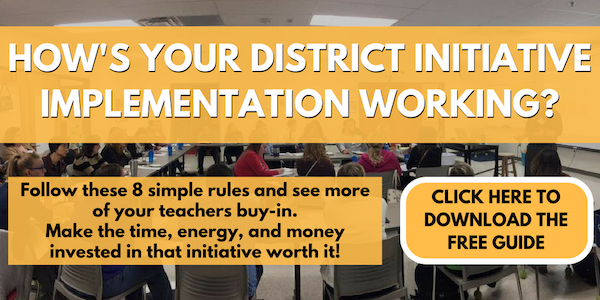If your school is not already on social media, it should be.
There’s no denying the fact that social media is now simply a part of our lives. Studies show that 74% of all online American adults use social media daily. When we look at students, that number jumps to 81% (of all teens 12-17).
As an administrator, you understand that communicating with your students, parents, other stakeholders, and your community is crucial to the continued success of your district or school. And we’re now in an era of education when competition between schools, and the need to market your school to build and retain enrollment, are more important than ever.
Your audience is on social media, and they’re on it a lot. If you’re not taking advantage of it, you’re missing a lot of opportunity to connect with and build relationships with that audience.
Working with schools around the country, one of the most common reasons we hear for a district not being on social media is simply because they don’t know where to start or what to do. So let’s look at 6 things your school or district should do to get started on social media.
1. Set Goals
Figure out what you’re trying to accomplish. Are you simply looking to keep folks up to date on school news and important events, or are you aiming to connect and engage with your audience in an attempt to build trust in your community and increase enrollment? Whatever your goals are, lay them out, make them S.M.A.R.T. (Specific, Measurable, Achievable/Attainable, Relevant/Realistic, Time-Based), and make sure your team knows what they are, and agrees with them.
2. Create District Guidelines
Do not start using social media until you have guidelines set for how you, your staff, and your students may or may not use it. This is not somewhere you want to skimp on. Take the time to think through how you want your district perceived, what actions could harm your school’s brand, and how you plan to handle the safety, security, and privacy of all users.
[scroll down to keep reading]
3. Pick The Right Channels
In my former life running an online marketing firm, I worked with businesses of all shapes and sizes. One of the things I most often consulted on was social media. And one of the biggest mistakes I saw hundreds of businesses make was trying to dive into every social media platform all at once. We see schools make this same mistake time and time again…and it drives me crazy!
Let’s be clear here: Do NOT do this.
You do not need to be on every single social media platform. Instead, find the one (or 2 if you’re ambitious) that makes the most sense for you. Most likely, Facebook will be one of the first you should get on, as 79% of all internet users in the U.S. use it daily.
However, this doesn’t mean your audience prefers Facebook. Depending on your goals, it might make more sense to start with Instagram, Twitter, or even LinkedIn. Poll your community, talk with your teachers, ask your students. Find out where they would prefer to engage with your school, and start there.
Hiring local seo services can also work, as these professionals can cover everything from search engine optimization (SEO) to social media marketing (SMM) and search engine marketing (SEM). This can instantly build the school’s online presence, plus help more families to find your school. If you are looking for a complete package in digital marketing services, you could get in touch with agencies similar to iTonic and others, in case you would want fruitful results for parents to get to know your school better.
However, if you are planning on handling the marketing yourselves, have the strategy in one platform and move on to the next.
4. Be Active
So what happens when a school tries to get on too many social media sites all at once?
Nothing, that’s what.
When you attempt to build a following, gain likes, engage, and monitor on multiple new platforms all at once, most likely utilizing one or two staff members who already have full plates, the likely result is going to be a bunch of social media profiles with little to no quality activity.
This is why focusing on one channel first is so important; it provides you with the opportunity to figure out your systems for sharing, engaging, and analyzing your social media efforts. And it allows you to ensure that profile gets the attention it needs, so it can actually have a positive impact.
Most importantly, though, don’t just create a profile and post random school updates twice a week. You don’t have to go crazy and be live streaming every day, but regardless of what platform you choose to start with, your goal should be a minimum of 1-2 posts per day. (Don’t worry, there are a ton of tools out there that allow you to schedule posts ahead of time.)
5. Monitor Posts and Engage
Staying on the topic of being active and posting at least 1-2 times every day, you need to also have a system for monitoring posts. Most social sites have mobile apps and options that allow you be notified when someone interacts with you. Whether it is someone liking your Facebook page, retweeting your latest update, or liking an image on Instagram, you should be monitoring the activity on your account. If you’re rocking with more than one platform, there are a variety of tools available (most with free versions) that allow you to monitor multiple accounts from a single dashboard. If you have the technical know-how within school, you could even maybe look at creating some sort of interactive content that could link with your website – such as an advert around the time parents start to look for schools – to really get your name out there.
Monitoring alone is not enough. You need to engage! It is called social media for a reason…be social! When someone comments on your Facebook page, comment back, have a conversation. When someone starts following you on Twitter, follow them back and thank them. If someone shares your Instagram post, share one of theirs and let them know you appreciate it. And look for ways to increase that engagement: Run polls, ask questions, and get your audience active on your profiles.
Be social.
6. Analyze Impact
Look, I’m not going to sit here and pretend that creating updates, sharing content, and engaging with your audience is going to be easy. It’s not. It’ll take some time to get systems in place, and it will take someone’s time to manage it all, which means it will cost you money, whether in the form of a new salary, an extra stipend, or work hours from a team member. So you better make sure it’s doing what you want it to.
When it comes to analyzing the impact of your social media efforts, there are a couple things to look at:
Profile analytics: These are the hard numbers you can access from almost any social media profile. Most platforms make it fairly easy to find statistics on a wide variety of things such as audience growth, reach (how many people saw your posts), and engagement (how many people interacted with you, and how often). These numbers show you how the content you share (Facebook updates, Tweets, Instagram images, etc) is being received by your audience. Web design companies such as Plenty of Pixels could come to your aid. No matter where you are located, this shouldn’t be difficult as there are many plenty of pixels locations – web design across the USA can be taken care of by them.
Community activity and support: This is a little more difficult to measure. You won’t necessarily find these in your profile analytics, although those numbers can also contribute to this analysis. What I’m talking about here is going to be measured more by your ability to “feel” how things have or have not changed in the relationship with your community. If your goal is to increase attendance at sporting events, you can assess what impact social media has had by analyzing attendance growth or drop off. If you’re trying to build a stronger relationship with stakeholders, you can look at conference attendance, the types of interactions you’re hearing/seeing, and by discussing with your team how they feel things are going. Again, these are all a little more difficult to measure, but you’re in your role as a leader for a bunch of reasons, and one of those is your ability to assess the relationship your school has with your community.
One Last Thing
One piece of advice I want to leave you with is to not get too caught up in the impact of your efforts too early on. Social media success does not happen over night. It takes time and effort. Give yourself a solid 6 months of utilizing social media before you give up and move on.
Yes, you should monitor your accounts from the very beginning, but understand that growing your audience will take time, and getting that audience to be actively engaged with you will take even more. Don’t get discouraged by a lack of growth within the first month or two. Stick to your plan, adjust based on audience feedback, and give it time. The most important thing is to stay consistent so you can make an informed decision down the road, whether to stick with your plan, or make changes.
The first step is starting. So consider these to-dos and make it happen! Once you get up and running, Tweet at me (@jeffgargas) and let me know how you’re utilizing social media for your school or district!
About Jeff Gargas
Jeff Gargas is the COO and co-founder of the Teach Better Team. Prior to co-founding Teach Better Team, Jeff was the owner of ENI Multimedia, an online marketing firm, where he worked with entrepreneurs and small businesses, assisting them with web design, social media, content marketing, and brand awareness.
Prior to all of this, Jeff was an adjunctive professor at Kent State University and spent 10+ years in the music industry. He has spoken at conferences around the country, and has successfully promoted more than 500 events and launched 7 businesses in a variety of industries.
Jeff is passionate about music, and enjoys spending time with his family as often as possible.
Top header image photo by Tim Bennett on Unsplash.
Sources: Sprout Social, Ignite Visibility, PewInternet.org.

